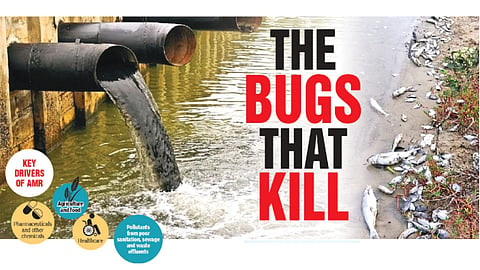

CHENNAI: With the superbugs posing a threat of causing over 10 million deaths in 2050, a report released by United Nations Environment Programme (UNEP) points out that environmental pollution is a major reason for antimicrobial resistance (AMR – microbes resistant to antibiotics) and urges the governments to strengthen environment.
For the uninitiated, microbes that are resistance to antibiotics are called superbugs. As per the report titled ‘Bracing for Superbugs’ released a few days ago, AMR was, directly and indirectly, responsible for an estimated 5 million deaths in 2019.
“By 2050, up to 10 million deaths could occur annually – on par with the 2020 rate of cancer deaths. If unchecked, AMR could shave off $3.4 trillion annually and push 24 million people into extreme poverty in the next decade,” the report warned.
It also pointed out that global attention to AMR has mainly focussed on human health and agriculture sectors, but there is growing evidence that the environment plays a key role in the development, transmission and spread of AMR.
“The environmental dimensions of AMR include pollution from hospital and community wastewater, effluents from pharmaceutical production, run-off originating from plant and animal agriculture and other forms of waste and releases. These matrices may contain not only resistant microorganisms, but also antimicrobials, various pharmaceuticals, microplastics, metals and other chemicals, which all increase the risk of AMR in the environment,” explains the report.
Polluted waterways, particularly those that have been polluted for some time, are likely to harbour microorganisms that increase AMR development and distribution in the environment. “With increasing pollution and lack of management of sources of pollution, combined with AMR in clinical and hospital settings and agriculture, risks are increasing,” it finds.
Even as Chennai is more prone to waterlogging and flooding, the report notes that flooding and urban rainwater-runoff also contribute to the increase in AMR. Landfill leachate and untreated sewage disposal carry a lot of resistant microorganisms and contribute to the spread of AMR in ground and surface water.
The report points out that around 400 emergent disease events have occurred since 1940, and 14 global outbreaks caused by microorganisms have been reported since 2000 including COVID-19.
Meanwhile, the World Bank has pointed out that interventions to address AMR are among the most cost-effective investments.
On the other hand, the Organisation for Economic Co-operation and Development (OECD) indicated that a public health package, costing just $2 per person, comprising measures to improve environmental hygiene and to implement antimicrobial stewardship, media campaigns and rapid diagnostics, would save 47,000 deaths per year in the OECD countries and the European Union.
The report recommends the need for a robust multisectoral coordination system by all stakeholders, especially environment ministries and agencies as key for tackling AMR in a sustainable manner. It also recommends strengthening national actions by boosting governance, planning and regulatory frameworks, through integrating AMR in national development planning and budgeting, and into environmental related plans and processes.
“Changes to reduce the risk of superbugs include solid regulation of discharges, strengthening wastewater treatment, realigning incentives to reduce the use of antimicrobials and private sector stepping up corporate responsibility,” the report said.
Visit news.dtnext.in to explore our interactive epaper!
Download the DT Next app for more exciting features!
Click here for iOS
Click here for Android